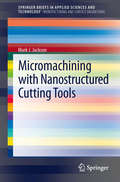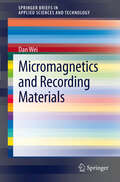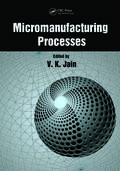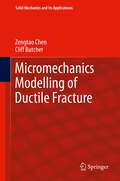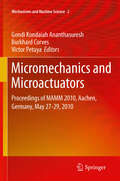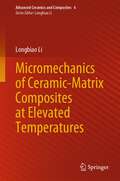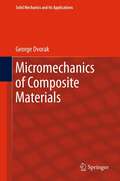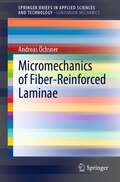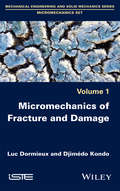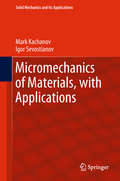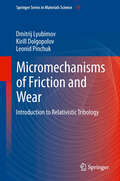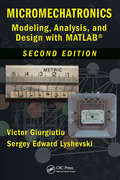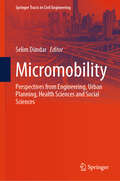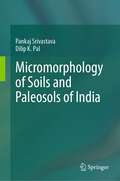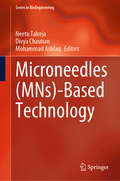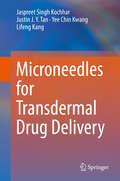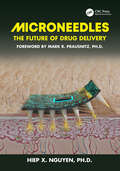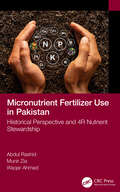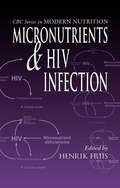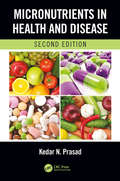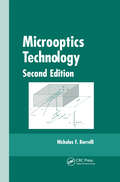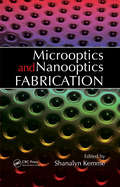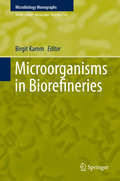- Table View
- List View
Micromachining with Nanostructured Cutting Tools
by Mark J. JacksonStress-reducing defects and subsequent microcracks are a central focus during micromachining processes. After establishing the central process of micromachining Micromachining with Nanostructured Cutting Tools explains the underlying theories that describe chip formation and applies elementary cutting theory to machining at the microscale. Divided into three parts, the second half of Micromachining with Nanostructured Cutting Tools develops on this introduction; explaining how frictional interactions between uncoated and micro tools coated with nanostructered coatings can be characterized by using the elementary micromachining theories that were initially developed for machining at the macroscale. Shaw's methods for calculating temperatures at the interaction zone and Merchant's methods for calculating mechanical interactions are well described and justified for machining steel in both the dry and wet states. Finally, the further development and use of micro tools coated with thin-film nanostructured diamonds are shown. Micromachining with Nanostructured Cutting Tools is a resource for engineers and scientists working in this new field of micro and nanotechnology. The explanations of how to characterize, apply and adapt traditional approaches of understanding the mechanics of practical machining to the machining of microproducts using nanostructured tools provides a reliable reference for researchers and practitioners alike.
Micromagnetics and Recording Materials
by Dan Wei"Micromagnetics and Recording Materials" is a book trying to give a systematic theory of computational applied magnetism, based on Maxwell equations of fields and Landau-Lifshitz equations of magnetic moments. The focused magnetic materials are magnetic recording materials utilized in computer hard disk drives. Traditionally, "Micromagnetics" includes the areas of "magnetization curve theory", "domain theory" and "read and write process analyses in recording systems". As Springer Briefs, this book includes the first two areas of micromagnetics. M-H loops of hard magnetic thin film media, soft magnetic layers and Tunneling MagnetoResistive spin valves are solved based on the microstructures of thin films. Static domain structures and dynamic switching processes are analyzed in the arbitrary-shaped magnetic devices such as write head pole tips and magnetic force microscope tips. The book is intended for researchers who are interested in applied magnetism and magnetic recording in all disciples of physical science. Prof. Dan Wei works at Tsinghua University, China.
Micromanufacturing Processes
by V. K. JainIncreased demand for and developments in micromanufacturing have created a need for a resource that covers both the science and technology of this rapidly growing area. With contributions from eminent professors and researchers actively engaged in teaching, research, and development, Micromanufacturing Processes details the basic principles, tools,
Micromechanics Modelling of Ductile Fracture
by Zengtao Chen Cliff ButcherThis book summarizes research advances in micromechanics modeling of ductile fractures made in the past two decades. The ultimate goal of this book is to reach manufacturing frontline designers and materials engineers by providing a user-oriented, theoretical background of micromechanics modeling. Accordingly, the book is organized in a unique way, first presenting a vigorous damage percolation model developed by the authors over the last ten years. This model overcomes almost all difficulties of the existing models and can be used to completely accommodate ductile damage developments within a single-measure microstructure frame. Related void damage criteria including nucleation, growth and coalescence are then discussed in detail: how they are improved, when and where they are used in the model, and how the model performs in comparison with the existing models. Sample forming simulations are provided to illustrate the model's performance.
Micromechanics and Microactuators
by Burkhard J. Corves Gondi Kondaiah Ananthasuresh Victor PetuyaThis book contains selected papers presented at MAMM 2010, the First Workshop on Microactuators and Micromechanisms. This workshop has brought together scientists, industry experts and students and has provided a special opportunity for know-how exchange and collaboration in various disciplines referring to microsystems technology. The conference was organized by the Technical Committees of Mechanical Transmissions and Micromachines under the patronage of IFToMM, the International Federation for the Promotion of Mechanism and Machine Science.
Micromechanics of Ceramic-Matrix Composites at Elevated Temperatures (Advanced Ceramics and Composites #6)
by Longbiao LiCeramic-matrix composites (CMCs) possess high specific strength and modulus at elevated temperature, and have already been applied in hot-section components in aero-engines. To ensure the operation reliability and safety of CMCs components, it is necessary to understand the micro damage mechanisms and internal damage state in the composites. This book focuses on the micromechanics of CMCs at elevated temperatures, including, the stress-strain behavior, proportional limit stress, residual strength, mechanical hysteresis, interface damage, strain response, and lifetime of CMCs at elevated temperatures. This book can help the material scientists and engineering designers to better understand and master the micromechanics of CMCs at elevated temperatures.
Micromechanics of Composite Materials
by George DvorakThis book presents a broad exposition of analytical and numerical methods for modeling composite materials, laminates, polycrystals and other heterogeneous solids, with emphasis on connections between material properties and responses on several length scales, ranging from the nano and microscales to the macroscale. Many new results and methods developed by the author are incorporated into the rich fabric of the subject, which has developed from the work of many researchers over the last 50 years. Among the new results, the book offers an extensive analysis of internal and interface stresses caused by eigenstrains, such as thermal, transformation and inelastic strains in the constituents, which often exceed those caused by mechanical loads, and of inelastic behavior of metal matrix composites. Fiber prestress in laminates, and modeling of functionally graded materials are also analyzed. Furthermore, this book outlines several key subjects on modeling the properties of composites reinforced by particles of various shapes, aligned fibers, symmetric laminated plates and metal matrix composites. This volume is intended for advanced undergraduate and graduate students, researchers and engineers interested and involved in analysis and design of composite structures.
Micromechanics of Fiber-Reinforced Laminae (SpringerBriefs in Applied Sciences and Technology)
by Andreas ÖchsnerThis book provides an introduction to the micromechanics of fiber-reinforced laminae, which deals with the prediction of the macroscopic mechanical lamina properties based on the mechanical properties of the constituents, i.e., fibers and matrix. Composite materials, especially fiber-reinforced composites, are gaining increasing importance since they can overcome the limits of many structures based on classical metals. Particularly, the combination of a matrix with fibers provides far better properties than the components alone. Despite their importance, many engineering degree programs do not treat the mechanical behavior of this class of advanced structured materials in detail, at least on the Bachelor degree level. Thus, some engineers are not able to thoroughly apply and introduce these modern engineering materials in their design process. The focus is on unidirectional lamina which can be described based on orthotropic constitutive equations. Three classical approaches to predict the elastic properties, i.e., the mechanics of materials approach, the elasticity solutions with contiguity after Tsai, and the Halpin–Tsai relationships, are presented. The quality of each prediction is benchmarked based on two different sets of experimental values. The book concludes with optimized representations, which were obtained based on the least square approach for the used experimental data sets.
Micromechanics of Fracture and Damage
by Djimedo Kondo Luc DormieuxThis book deals with the mechanics and physics of fractures at various scales. Based on advanced continuum mechanics of heterogeneous media, it develops a rigorous mathematical framework for single macrocrack problems as well as for the effective properties of microcracked materials. In both cases, two geometrical models of cracks are examined and discussed: the idealized representation of the crack as two parallel faces (the Griffith crack model), and the representation of a crack as a flat elliptic or ellipsoidal cavity (the Eshelby inhomogeneity problem). The book is composed of two parts: - The first part deals with solutions to 2D and 3D problems involving a single crack in linear elasticity. Elementary solutions of cracks problems in the different modes are fully worked. Various mathematical techniques are presented, including Neuber-Papkovitch displacement potentials, complex analysis with conformal mapping and Eshelby-based solutions. - The second part is devoted to continuum micromechanics approaches of microcracked materials in relation to methods and results presented in the first part. Various estimates and bounds of the effective elastic properties are presented. They are considered for the formulation and application of continuum micromechanics-based damage models.
Micromechanics of Materials, with Applications (Solid Mechanics and Its Applications #249)
by Igor Sevostianov Mark KachanovThis book on micromechanics explores both traditional aspects and the advances made in the last 10–15 years. The viewpoint it assumes is that the rapidly developing field of micromechanics, apart from being of fundamental scientific importance, is motivated by materials science applications. The introductory chapter provides the necessary background together with some less traditional material, examining e.g. approximate elastic symmetries, Rice’s technique of internal variables and multipole expansions. The remainder of the book is divided into the following parts: (A) classic results, which consist of Rift Valley Energy (RVE), Hill’s results, Eshelby’s results for ellipsoidal inhomogeneities, and approximate schemes for the effective properties; (B) results aimed at overcoming these limitations, such as volumes smaller than RVE, quantitative characterization of “irregular” microstructures, non-ellipsoidal inhomogeneities, and cross-property connections; (C) local fields and effects of interactions on them; and lastly (D) – the largest section – which explores applications to eight classes of materials that illustrate how to apply the micromechanics methodology to specific materials.
Micromechanisms of Friction and Wear
by Leonid Pinchuk Dmitrij Lyubimov Kirill DolgopolovThe modern vision of the micromechanism of friction and wear is explored, from the examination of ideal and real crystal structure and adhesion properties to the dynamics of solid frictional interaction. The fundamental quantum-mechanical and relativity principles of particle interaction are considered as basis of friction micro-process examination. The changes in solid structure originated from the influence of different kinds of force fields are considered. The principal possibility of relativity effect manifestation by friction is explained. The critical state of friction - triboplasma - was studied. Structural peculiarities of triboplasma, the kinetics of its transformation during frictional interaction as well as the influence of plasma and postplasma processes on tribojunction friction characteristics and complex formation by friction were examined. The book addresses to tribology researchers.
Micromechatronics: Modeling, Analysis, and Design with MATLAB, Second Edition (Nano- and Microscience, Engineering, Technology and Medicine)
by Victor Giurgiutiu Sergey Edward LyshevskiFocusing on recent developments in engineering science, enabling hardware, advanced technologies, and software, Micromechatronics: Modeling, Analysis, and Design with MATLAB, Second Edition provides clear, comprehensive coverage of mechatronic and electromechanical systems. It applies cornerstone fundamentals to the design of electromechanical syst
Micromobility: Perspectives from Engineering, Urban Planning, Health Sciences and Social Sciences (Springer Tracts in Civil Engineering)
by Selim DündarThis book provides a comprehensive overview on micromobility, which is a mode of transportation that has become particularly popular among young people in recent years, due to the impact of the COVID-19 pandemic, and supports public transport for short distances. It includes contributions by an interdisciplinary pool of authors from civil engineering, urban and regional planning, law, social sciences, physiotherapy, and rehabilitation. It demonstrates that micromobility is a developing mode of transportation and represents a service that needs to be integrated into the transportation system. The book addresses micromobility from various perspectives, making it a reference tool for researchers, transportation planners, operators, decision-makers, and policy-makers. A special focus is put on the effects of micromobility on health, the business models, and the legal status of micromobility systems, reflecting perspectives from both health sciences and social sciences.
Micromorphology of Soils and Paleosols of India
by Pankaj Srivastava Dilip K. PalThis monograph covers uniqueness of micromorphology in resolving many important but enigmatic pedological issues such as clay illuviation, formation of pedogenic and non-pedogenic CaCO3, modification of plasmic fabric, contemporary and relict pedogenic processes, polygenesis of soils in Alfisols, Mollisols, Ultisols, Vertisols and Inceptisols of the tropical Indian environments. Chapters in this title also include identification of paleosols, diagenetic overprinting of the pedofeatures in lithified paleosols, and alluvial cyclicity of the fluvial successions. The techniques mentioned in this title are of tremendous value in pedological and geological research for precise and unambiguous definitions of soil taxa to build the national soil information and refine the stratigraphy of the terrestrial sediments. The information is for the benefit the students and researchers of pedology and geomorphology who often come across extreme difficulties in relating to examples applying the principles of soil formation from textbooks devoted almost exclusively to soils of the temperate climates. The format of this publication is arranged for a process-oriented text and figures on micromorphology of the tropical soils and paleosols as a reference for pedologists, earth scientists, M.Sc. and Ph.D. students, and also for land resource managers who are engaged in enhancing the productivity of such tropical soils in India and elsewhere.
Microneedles (Series in BioEngineering)
by Neetu Talreja Divya Chauhan Mohammad AshfaqThis book highlights the fabrication of various types of solid, hollow, and dissolvable microneedles (MNs) using various synthesis processes and their applications in medicine, agriculture, and sensors. MN-based technology emerges as a sign of hope, offering a painless delivery system. In general, MN-based technology uses tiny needles to puncture the outermost layer of the skin. MNs are made of various materials like metals, silicon, and polymers for efficient delivery of biomolecules. With the tremendous success of MNs in the drug delivery system, researchers try to use MNs in agriculture and sensor applications to improve plant health via monitoring and delivery of agrochemicals. By modulating the materials of MNs, drugs and biomolecules can be delivered in a controlled manner. In general, MN-based technology holds significant opportunities for improving delivery of the drugs/biomolecules and opens new wings toward agriculture and sensing applications. Moreover, MN-based technology enables newer avenues for therapeutic and diagnosis of diseases.
Microneedles for Transdermal Drug Delivery
by Jaspreet Singh Kochhar Yee Chin Kwang Lifeng Kang Justin J. TanThis monograph covers a novel technology to deliver drugs and cosmetics through the skin in a minimally invasive manner. Microneedles – a bed of miniaturized needles is one of the most studied topics in delivering actives through the skin barrier. This book enables readers to understand the delivery of ingredients through the skin, describes a novel and simple method to fabricate microneedles containing a range of small and large molecular weight compounds, studies their physical properties as well as delivery through the skin layers. Readers will discover this book to be extremely beneficial to help them understand the state of the field of transdermal drug delivery, with extensive coverage including experimental data on basics of microneedle fabrication technology using photolithography, encapsulation of drugs within the polymeric matrix of microneedles and studying their release patternsin vitro and ex vivo . Academic researchers, pharmaceutical and cosmeceutical industry as well as students of skin science will find this account very useful in their pursuits. As microneedles grow and develop into a commercial reality with more actives being delivered and significant clinical research being put in, this account will hold well in providing basic principles and knowledge together with rigorous experimental data.
Microneedles: The Future of Drug Delivery
by Hiep Xuan NguyenThe microneedle field has been expanding exponentially with innovative designs and various applications, thus capturing the interest of academic industry and regulatory sectors. Microneedles: The Future of Drug Delivery equips readers with a comprehensive understanding of microneedles: from percutaneous absorption to microneedles production, characterization, applications in drug delivery and diagnosis, to practical perspectives on the development, manufacturing, regulatory issues, and commercialization of microneedles. This book is written by a single author and thus provides complex information in a simple, elegant, and cohesive style. The book is intended for graduate students, researchers, scientists, and engineers working in the pharmaceutical, medical, cosmeceutical, and biotechnology industry.
Micronutrient Fertilizer Use in Pakistan: Historical Perspective and 4R Nutrient Stewardship
by Waqar Ahmad Abdul Rashid Munir ZiaMicronutrient research has been an important component of the soil fertility and plant nutrition program in Pakistan since the identification of zinc deficiency in rice in 1969. Since then, considerable progress has been made on diagnosis and management of micronutrient nutrition problems in crops. However, now there is growing R&D evidence that micronutrient malnutrition in humans could be addressed through enriching staple food grains with micronutrients. This book presents the latest R&D information on micronutrient problems in crop plants/cropping systems and their corrective measures. The current status, the constraints, and economic benefits of using micronutrient fertilizers for optimizing crop productivity and soil resource sustainability are discussed along with estimating future potential requirement of micronutrient fertilizers to optimize crop productivity, produce quality, and soil resource sustainability. Wide-scale preventable micronutrient deficiencies in human populations originate from micronutrient-deficient soils over which staple cereals and other food crops are grown. This book summarizes R&D information on fertilizer use-based micronutrient biofortification in staple food grains to address "hidden hunger" in human populations. The book also presents the best management practices by which micronutrient deficiencies could be corrected in crop plants in a farmer-friendly manner. Features Reviews the micronutrients R&D carried out in Pakistan over the past five decades Focuses on soil–plant analysis techniques for effective prognosis and diagnosis of micronutrient disorders Presents spatial variability maps of micronutrient deficiencies in agricultural soils and crops Provides value–cost ratios of using micronutrient fertilizers for major crops Works out current use level of micronutrient fertilizers and their potential future requirements in the country Discusses agronomic biofortification approach for enriching crop-based food with micronutrients to address "hidden hunger" Presents a compelling case for enhanced use of the deficient micronutrient fertilizers to optimize crop productivity, farmer income, and national economy Presents micronutrient fertilizer use recommendations for salient crops and discusses fertilizer use for micronutrients in the context of 4R nutrient stewardship Recommends future R&D needed for optimizing micronutrient nutrition of crops
Micronutrients and HIV Infection (Modern Nutrition)
by Henrik FriisExploring the role of micronutrients in HIV, this book provides a comprehensive a review of recently published human studies and intervention trials and other important epidemiology based literature. It covers the history, biochemistry, biological functions, and food sources of individual micronutrients and reviews their roles in host defense and resistance to infections in general, and HIV in particular. The editorial panel presents a critical analysis of how existing micronutrient interventions can be promoted, expanded, and modified to reduce the impact of the HIV pandemic. They discuss how this information can be applied in countries where HIV is widespread and treatment unavailable.
Micronutrients in Health and Disease, Second Edition
by Kedar PrasadIncreased oxidative stress due to the production of excessive amounts of free radicals along with the effects of chronic inflammation plays a major role in the initiation and progression of most chronic diseases. In addition, increased release of glutamate plays a central role in the pathogenesis of various disorders. <p><p>This second edition of Micronutrients in Health and Disease proposes a novel concept that in order to simultaneously and optimally reduce oxidative stress, chronic inflammation, and glutamate, it is essential to increase levels of antioxidant enzymes as well as levels of dietary and endogenous antioxidant compounds at the same time. This is accomplished by activating the Nrf2 pathways and by increasing the levels of antioxidant compounds and B-vitamins through supplementation. This book proposes a mixture of micronutrients that achieves this above goal. The mixture of micronutrients together with modification in diet and lifestyle may reduce the risk of chronic diseases and in combination with standard care, may improve the management of these diseases. <p><p>KEY FEATURES <li>Provides evidence in support of the idea that increased oxidative stress, chronic inflammation, and glutamate are involved in the pathogenesis of chronic diseases. <li>Contains three new chapters on Huntington’s disease, Autism spectra, and Prion disease. <li>Discusses the role of microRNAs in the pathogenesis of chronic diseases. <li>Presents information on regulation of the expression of microRNAs by reactive oxygen species and antioxidants. <p><p>Micronutrients in Health and Disease, Second Edition serves as a valuable resource for those seeking to promote healthy aging and prevent and improved management of chronic diseases.
Microoptics Technology: Fabrication and Applications of Lens Arrays and Devices
by Nicholas F. BorrelliIt has been five years since the publication of the first edition of Microoptics Technology. In that time, optical technology has experienced an unparalleled burst of activity that has produced a body of significant real results that have advanced new materials, devices, and systems. Building on the foundation of the first edition, this comprehensive reference presents an introduction and review of the optics and methods of microoptic elements with particular emphasis on lenses and lens arrays.The author explores advances that emerged from the flurry of activity over the last five years. With two new chapters and another fully expanded, the book covers current and new methods of fabrication of microlenses, as well as refractive, GRIN, and diffractive methods. It also includes chapters on optical devices that utilize the microoptic fabrication methods, including micro-diffraction gratings and optical isolators, together with a discussion of a number of important applications. See what's new in the Second Edition:Coverage of negative refractive index materialsInformation on femto second laser interaction with materialsChapter on photonic crystal has been extensively expandedThe first edition was the first resource to collect all microlens fabrication methods into a single volume. With more than 600 references, tables, equations, drawings, and photographs, Microoptics Technology, Second Edition replaces its predecessor as the gold standard reference in this field.
Microoptics and Nanooptics Fabrication
by Shanalyn A. KemmeThe deep interconnection between micro/nanooptical components and related fabrication technologies—and the constant changes in this ever-evolving field—means that successful design depends on the engineer’s ability to accommodate cutting-edge theoretical developments in fabrication techniques and experimental realization.Documenting the state of the art in fabrication processes, Microoptics and Nanooptics Fabrication provides an up-to-date synopsis of recent breakthroughs in micro- and nanooptics that improve key developmental processes. This text elucidates the precise and miniaturized scale of today’s fabrication methods and their importance in creating new optical components to access the spectrum of physical optics. It details successful fabrication techniques and their direct effect on the intended performance of micro- and nanooptical components. The contributors explore the constraints related to material selection, component lateral extent, minimum feature size, and other issues that cause fabrication techniques to lag behind corresponding theory in the development process. Written with the professional optical engineer in mind, this book omits the already well-published broader processing fundamentals. Instead it focuses on key tricks of the trade helpful in reformulating processes to achieve necessary optical targets, improve process fidelity, and reduce production costs. The contributing authors represent the vanguard in micro-optical fabrication. The result of their combined efforts, this searing analysis of emerging fabrication technologies will continue to fuel the expansion of optics components, from the microwave to the infrared through the visible regime.
Microorganisms in Biorefineries
by Birgit KammThe book describes how plant biomass can be used as renewable feedstock for producing and further processing various products. Particular attention is given to microbial processes both for the digestion of biomass and the synthesis of platform chemicals, biofuels and secondary products. Topics covered include: new metabolic pathways of microbes living on green plants and in silage; using lignocellulosic hydrolysates for the production of polyhydroxyalkanoates; fungi such as Penicillium as host for the production of heterologous proteins and enzymes; bioconversion of sugar hydrolysates into lipids; production of succinic acid, lactones, lactic acid and organic lactates using different bacteria species; cellulose hydrolyzing bacteria in the production of biogas from plant biomass; and isoprenoid compounds in engineered microbes.
Microorganisms in Environmental Management
by Bhavdish Narain Johri Anil Prakash T. SatyanarayanaMicrobes and their biosynthetic capabilities have been invaluable in finding solutions for several intractable problems mankind has encountered in maintaining the quality of the environment. They have, for example, been used to positive effect in human and animal health, genetic engineering, environmental protection, and municipal and industrial waste treatment. Microorganisms have enabled feasible and cost-effective responses which would have been impossible via straightforward chemical or physical engineering methods. Microbial technologies have of late been applied to a range of environmental problems, with considerable success. This survey of recent scientific progress in usefully applying microbes to both environmental management and biotechnology is informed by acknowledgement of the polluting effects on the world around us of soil erosion, the unwanted migration of sediments, chemical fertilizers and pesticides, and the improper treatment of human and animal wastes. These harmful phenomena have resulted in serious environmental and social problems around the world, problems which require us to look for solutions elsewhere than in established physical and chemical technologies. Often the answer lies in hybrid applications in which microbial methods are combined with physical and chemical ones. When we remember that these highly effective microorganisms, cultured for a variety of applications, are but a tiny fraction of those to be found in the world around us, we realize the vastness of the untapped and beneficial potential of microorganisms. At present, comprehending the diversity of hitherto uncultured microbes involves the application of metagenomics, with several novel microbial species having been discovered using culture-independent approaches. Edited by recognized leaders in the field, this penetrating assessment of our progress to date in deploying microorganisms to the advantage of environmental management and biotechnology will be widely welcomed.
Microorganisms in Foods 7: Microbiological Testing In Food Safety Management (Microorganisms In Foods Ser. #Vol. 7)
by International Commission on Microbiological Specifications for FoodsThe second edition of Microorganisms in Foods 7: Microbiological Testing in Food Safety Management updates and expands on information on the role of microbiological testing in modern food safety management systems. After helping the reader understand the often confusing statistical concepts underlying microbiological sampling, the second edition explores how risk assessment and risk management can be used to establish goals such as a “tolerable levels of risk,” Appropriate Levels of Protection, Food Safety Objectives or Performance Objectives for use in controlling foodborne illness. Guidelines for establishing effective management systems for control of specific hazards in foods are also addressed, including new examples for pathogens and indicator organisms in powdered infant formula, Listeria monocytogenes in deli-meats, enterohemorrhagic Escherichia coli in leafy green vegetables, viruses in oysters and Campylobacter in poultry. In addition, a new chapter on application of sampling concept to microbiological methods, expanded chapters covering statistical process control, investigational sampling, environmental sampling, and alternative sampling schemes. The respective roles of industry and government are also explored, recognizing that it is through their collective actions that effective food safety systems are developed and verified. Understanding these systems and concepts can help countries determine whether imported foods were produced with an equivalent level of protection. Microorganisms in Foods 7 is intended for anyone using microbiological testing or setting microbiological criteria, whether for governmental food inspection and control, or industrial applications. It is also intended for those identifying the most effective use of microbiological testing in the food supply chain. For students in food science and technology, this book provides a wealth of information on food safety management principles used by government and industry, with many references for further study. The information was prepared by the International Commission on Microbiological Specifications for Foods (ICMSF). The ICMSF was formed in response to the need for internationally acceptable and authoritative decisions on microbiological limits for foods in international commerce. The current membership consists of fifteen food microbiologists from twelve countries, drawn from government, universities, and food processing and related industries.
